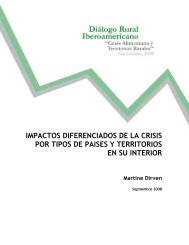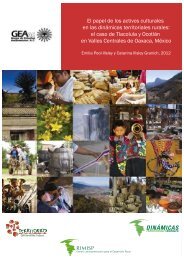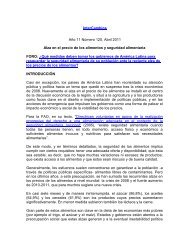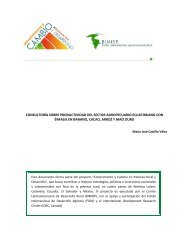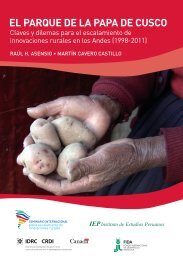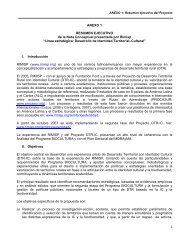Vietnam's Agrarian Reform, Rural Livelihood and Policy ... - Rimisp
Vietnam's Agrarian Reform, Rural Livelihood and Policy ... - Rimisp
Vietnam's Agrarian Reform, Rural Livelihood and Policy ... - Rimisp
You also want an ePaper? Increase the reach of your titles
YUMPU automatically turns print PDFs into web optimized ePapers that Google loves.
1. <strong>Agrarian</strong> <strong>Reform</strong> Process in VietnamBy the mid-1980s, it became painfully clear that Vietnam’s system of collective agriculture was notworking. In 1987, after several years of slow growth, food production actually declined by 4.4 percent<strong>and</strong> famine struck parts of the country. Making matters worse, inflation had risen from 92 percent in1985 to 775 percent in 1986, making food more <strong>and</strong> more expensive for the country’s population of 60million.At the Sixth National Party Congress in December 1986, the Vietnamese Communist Party enacted aseries of reforms that would ultimately transform Vietnam from a centrally planned economy to amarket-oriented one. The reform process, known as Doi Moi, did not really take hold until 1988, butonce the collectives were dismantled, l<strong>and</strong>-use rights were assigned to farmers, agricultural marketswere liberalized, <strong>and</strong> wider economic reforms were implemented. As a result, Vietnam’s economy tookoff. For about a decade starting in the early 1990s, the country’s gross domestic product (GDP) grewat an annual rate of 7.6 percent thanks in large part to the rapid increase in agricultural growth, whichgrew 4.9 percent annually between 1996 <strong>and</strong> 2000, when the growth rate reached an all-time high(Minot et al., 2006; Sephri <strong>and</strong> Akram-Lodhi, 2002).The reforms unleashed a new entrepreneurial spirit in Vietnam, both in agriculture <strong>and</strong> in othersectors. Farmers intensified rice production, diversified into new crops such as coffee <strong>and</strong> cashews,<strong>and</strong> improved the quality of the food they produced. By stimulating agricultural <strong>and</strong> overall economicgrowth, the reforms helped reduce rural poverty, hunger, <strong>and</strong> malnutrition. In just five years—from1993 to 1998—the share of people living in poverty fell by 21 percent. Among children younger thanfive, the rate of stunting—meaning a low height for age, a symptom of poor nutrition—declined from 53to 33 percent during the same period (Fritzen, 2002).1.1. Collective Agriculture in Vietnam: 1954-1988When Vietnam achieved independence from France in 1954, the Geneva Accords divided it into twocountries with opposing ideologies—the Democratic Republic of Vietnam in the north adopted asocialist ideology influenced by China <strong>and</strong> the Soviet Union, <strong>and</strong> the Republic of Vietnam in the southpursued a capitalist ideology influenced by the United States. Civil war soon followed.2




